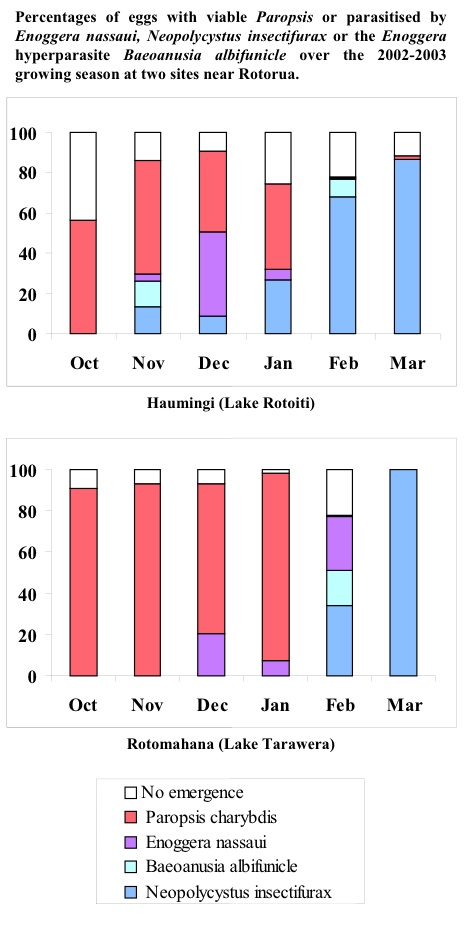PESTS AND DISEASES OF FORESTRY IN NEW ZEALAND
Paropsis charybdis update, June 2003
Scion is the leading provider of forest-related knowledge in New Zealand
Formerly known as the Forest Research Institute, Scion has been a leader in research relating to forest health for over 50 years. The Rotorua-based Crown Research Institute continues to provide science that will protect all forests from damage caused by insect pests, pathogens and weeds. The information presented below arises from these research activities.
From Forest Health News 130, June 2003.
During the summer of 2001-2002, eucalypt growers experienced an outbreak of the eucalyptus tortoise beetle (Paropsis charybdis) worse than has been seen for many years. The unseasonably wet weather may have been a factor, but growers were concerned that the arrival of a tiny wasp from Australia may have compromised the effectiveness of Enoggera nassaui , deliberately introduced in the late 1980s and again in 2000 to control Paropsis populations by parasitising its eggs. Baeoanusia albifunicle , an obligate hyperparasitoid (A parasitoid of a parasitoid) of Enoggera nassaui, was first detected here in 2001 (FHNews 117:1).

More information was urgently needed, so Forest Research entomologists undertook monitoring studies in Eucalyptus nitens plantations in the central North Island between September 2002 and April 2003. In the first few months E. nassaui successfully parasitised up to 50% of P. charybdis eggs. However, B. albifunicle was already present in samples in December, and by late summer E. nassaui was hyperparasitised and rendered inoperative in an average of 60% of parasitised eggs. This resulted in a drop in the effective parasitism of Paropsis eggs to about 10% on average, and the percentage of viable Paropsis eggs correspondingly ranged from 2% to as much as 53%. These observations have confirmed that by reducing the Enoggera populations, B. albifunicle has the potential to check its efficacy as a biological control agent of P. charybdis , especially late in the season when historically it was once responsible for up to 90% parasitism of second generation eggs.
However, the recent discovery of a second parasitoid of Paropsis charybdis , Neopolycystus insectifurax , lends hope for the future control of this pest, since species of Neopolycystus are not hyperparasitised by B. albifunicle . Neopolycystus insectifurax , also a diminutive wasp, was originally released as a potential biological control in New Zealand in the late 1980s along with E. nassaui but failed to establish at that time. It is believed that the recurrence of N. insectifurax originates from a separate and more recent chance introduction rather than from those released in the late 1980s. Neopolycystus insectifurax was detected at the sampling sites only sporadically in December, but parasitism of Paropsis by this insect increased steadily as the season progressed, reaching high levels in Autumn. This implies that N. insectifurax is able to provide effective control of the second generation population of P. charybdis (see figures). Neopolycystus insectifurax was present at three out of four sites monitored over the 2002-2003 season, and at one site near Reporoa it achieved 80% parasitism of the eggs laid by the second generation of Paropsis adults.
Diane Jones and Toni Withers, Forest Research
This information is intended for general interest only. It is not intended to be a substitute for specific specialist advice on any matter and should not be relied on for that purpose. Scion will not be liable for any direct, indirect, incidental, special, consequential or exemplary damages, loss of profits, or any other intangible losses that result from using the information provided on this site.
(Scion is the trading name of the New Zealand Forest Research Institute Limited.)



